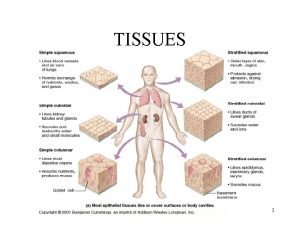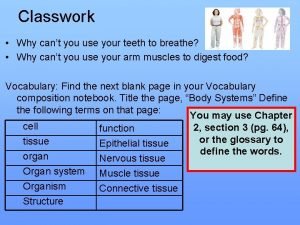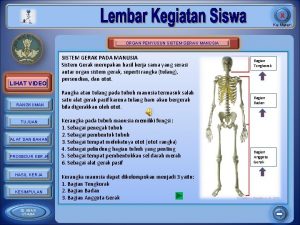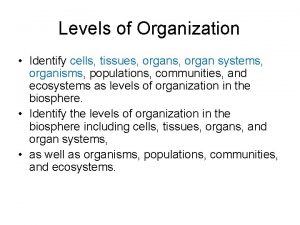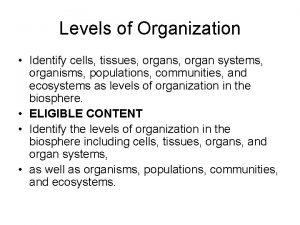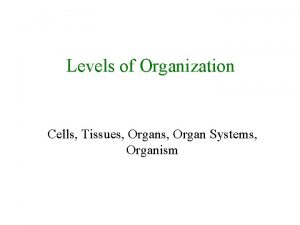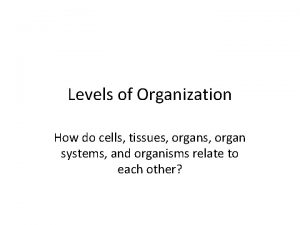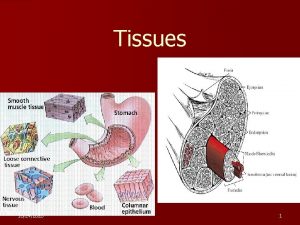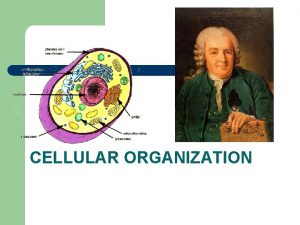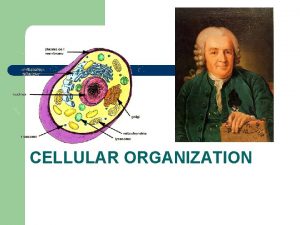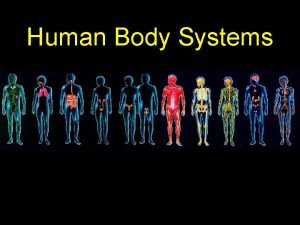Levels of Organization Identify cells tissues organ systems















- Slides: 15

Levels of Organization • Identify cells, tissues, organ systems, organisms, populations, communities, and ecosystems as levels of organization in the biosphere. • Identify the levels of organization in the biosphere including cells, tissues, organs, and organ systems, • as well as organisms, populations, communities, and ecosystems.

Levels of Organization • Cell—Basic unit of structure and function in organisms. – Some organisms, like bacteria and protists, are unicellular (made entirely of one cell). – Some organisms, like fungi, plants, and animals, are multicellular (made of many cells). – Bacteria have prokaryotic cells. – Protists, Fungi, Plants, and Animals have eukaryotic cells. – In multicellular organisms, cells exhibit cell specialization. They take on specific jobs and look different from each other. – The cells also exhibit division of labor. They split up the work of the organism.


Levels of Organization • Tissues—Groups of similar cells that work together to perform a specific function. – 4 major tissue types in animals • • Epithelial tissue Connective tissue Muscle tissue Nervous tissue

Levels of Organization • Organs—structures made of different types of tissues that work together to perform a specific function. – Examples • • • Heart Lungs Stomach Small intestine Liver Large Intestine Gall Bladder Plant Roots Plant Stems Plant Leaves

Levels of Organization • Organ Systems—Groups of organs that work together to perform a specific function. – Examples: • • Digestive system Circulatory system Respiratory system Nervous system Muscular system Skeletal system Integumentary system (skin) Vascular system in plants

Levels of Organization • Organism—A complete, individual living thing. • Examples: – A single person – A single plant – A single bacterium – A single protist


Questions 1) Select the largest level of organization among the following: a. b. c. d. Organ system Organism Tissue

2) Select the smallest level of organization among the following: a. b. c. d. Organ system tissue Cells

3) Life is organized in a hierarchical fashion. Which of the following sequences illustrates that hierarchy as it goes upward? a. b. c. d. Organ system, cell, organism Organism, organ system, organ, cell Cell, organ system, organism Cell, organism, organ system, organ

4) A group of cells that are combined and perform a specific function are called: a. Cells b. Organs c. Tissues d. Population

Short answer 1) What are the differences between cells and organs? 2) How are tissues different from organs? 3) What makes up an organ system? Give an example along with the system parts. 4) What is it called when a group of tissues come together to perform a specific function?

Reminder! • Make sure you understand can apply the following…

 Cells-tissues-organ-systems-organism
Cells-tissues-organ-systems-organism Body tissues chapter 3 cells and tissues
Body tissues chapter 3 cells and tissues Four major tissue types
Four major tissue types Body tissues chapter 3 cells and tissues
Body tissues chapter 3 cells and tissues Cells form tissues. tissues form __________.
Cells form tissues. tissues form __________. Body tissues chapter 3 cells and tissues
Body tissues chapter 3 cells and tissues Tissues are groups of similar cells working together to
Tissues are groups of similar cells working together to Tissues are groups of similar cells working together to
Tissues are groups of similar cells working together to Chapter 3 cells and tissues
Chapter 3 cells and tissues Chapter 3 cells and tissues figure 3-1
Chapter 3 cells and tissues figure 3-1 Chapter 3 cells and tissues figure 3-1
Chapter 3 cells and tissues figure 3-1 A group of cells similar in structure and function
A group of cells similar in structure and function Identify this tissue
Identify this tissue Cell tissue organ organ system organism
Cell tissue organ organ system organism Cells group together to form
Cells group together to form Organ penyusun sistem gerak pada tumbuhan
Organ penyusun sistem gerak pada tumbuhan







